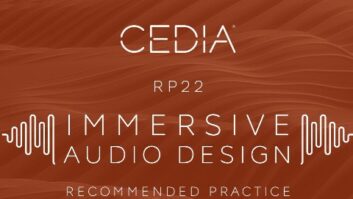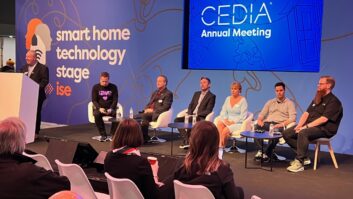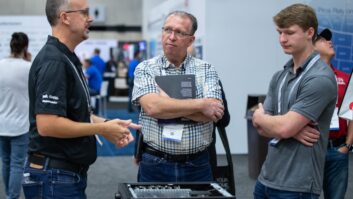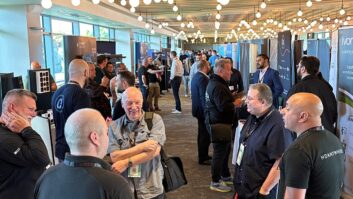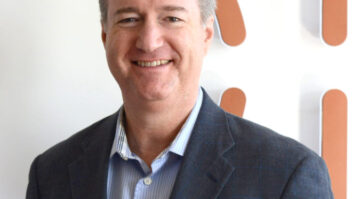CEDIA recently held a focus group, comprising architects and CEDIA Home Technology Professionals to help each discipline better understand each other and improve working relationships for the future. TFA reports. As part of its outreach programme, CEDIA (the Custom Electronic Design & Installation Association) recently held a focus group, comprising architects and CEDIA Home Technology Professionals to help each profession better understand each other and improve working relationships for the future.
As smart home technology becomes more pervasive and more desirable, it is increasingly important for architects to recognise the importance of audio-visual, lighting control and other integrated electronic systems and the impact that these systems can have on the design of a project. At the same time, it is essential that CEDIA members appreciate what information and support architects need to enable them to consider and allow for technology at the early stages of a project.
The sooner technology is thought about in a project, the more likely it is that design complications will be avoided further down the line. Correct cabling, equipment positioning, effective concealment and optimum performance demand advanced planning.@page_break@
This was one of the key discussion points of the CEDIA focus group, which was held in October at the Cornflake Smart App-artment in London. Representatives from Kticic Architects, Flynn Associates, Asif Malik Architect, SaTT Architects & Designers and The Honourable Society of the Inner Temple attended the group, alongside Tim Marsden from AMX, Iain Shaw of Brilliant Living and CEDIA’s Hannah Dixon.
Timing is indeed everything. And it became clear that for the majority of participants, the initial driver in the conversation about home technology is the client and they are fairly specific on what type of systems they want. It appears that consumers are becoming much more tech-savvy these days. The group felt that this could be down to the fact that technology in the home is now more practical and familiar. Yes, technology is still mainly installed in hi-end properties, but it is no longer classed as being ‘sci-fi’ and out of reach.
Of course, clients can also purchase many of the smart home technologies that would be integrated by a CEDIA member directly themselves in shops and online. While this is the case, it is important for architects to make clear that when they do so, they are simply buying gadgets, and not home automation. Systems need to be fully integrated into the home; otherwise, homeowners will still face the nightmare scenario of having to use four different remotes to operate the TV. @page_break@
The group also agreed that there are other clients who aren’t so clued up on technology and expect the architect to provide answers on what can be achieved. Whilst most architects may have a broad understanding, it was felt that they don’t always have the in-depth knowledge needed to answer specific questions. It’s at this point that they should call upon Home Technology Professionals to come in and advise the client on the best way forward.
The conversation soon moved on to sustainability. Energy-efficient homes are becoming more common, with the increasing specification of solar panels, LED lighting and other products. The smart home technology industry has also taken this on board and offers approaches that can effectively integrate and control these products to improve performance. However, it was interesting to hear that control and integration to reduce energy doesn’t always appear to be a high priority for clients. For many, having technology installed in the home is all about status – they want the biggest and best systems and aren’t as concerned as architects would like about whether the products are energy efficient.
The younger generation does seem more inclined to pay attention to environmental issues. If there is an obvious payback, then this may encourage the client to opt for more energy-efficient technologies and better control to go with it, but, generally, it doesn’t rate highly on the wish list, not as much as having an ‘all singing, all dancing’ home cinema.@page_break@
Moving the conversation on to talk more about CEDIA, it is clear that the association provides a number of useful resources and that architects are benefitting from these initiatives. To support the need for the two specialists to begin working together at the early stages CEDIA released a Recommended Wiring Guidelines document earlier this year. Those who attended the discussion mentioned that cabling is a big issue for them, and that this resource is extremely helpful to overcome any problems in this area.
It was also discussed that the CPD courses that CEDIA offer are hugely valuable. Whilst they provide a great understanding of the industry as a whole, it was suggested that additional courses, which focus on particular topics in-depth, could be worth exploring. These suggestions included technologies for outdoor applications, cabled versus wireless solutions and a focus on technology to help disabled people and the elderly.
The CEDIA representatives made it clear that they are dedicated to providing architects with exactly what they require with regards to smart home technology and will be looking at expanding the CPD programme in the future. On a final note, it was encouraging to hear that those architects present favour using the services of CEDIA member companies. Whilst they do rely heavily on recommendations, they are aware that by partnering on projects with a CEDIA member means that they are working with well-trained, competent professionals.
www.cedia.org
CEDIA focuses on architects
CEDIA recently held a focus group, comprising architects and CEDIA Home Technology Professionals to help each discipline better understand each other and improve working relationships for the future. TFA reports.

